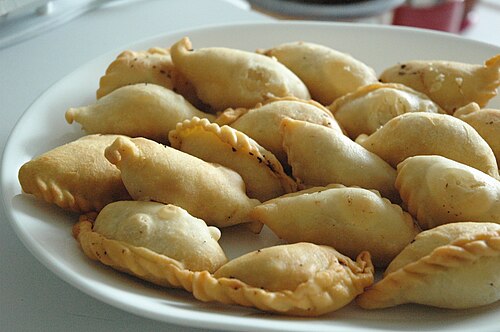 | This article has multiple issues. Please helpimprove it or discuss these issues on thetalk page.(Learn how and when to remove these messages) (Learn how and when to remove this message)
|
 | |
| Alternative names | Chandrakala are half-moon shaped, while the circular discs are Suryakala |
|---|---|
| Type | Dumpling |
| Course | Dessert |
| Place of origin | Indian subcontinent |
| Region or state | Indian subcontinent |
| Main ingredients | Suji,Maida flour,wheat flour,khoa,Coconut,Raisins, crushedAlmonds,Walnuts,Cashews,Pistachios |
Gujhia, also known asgujiya,gujia,gughara,pedakiya,purukiya,karanji,kajjikayalu,somas, orkarjikayi, is a sweet, deep-friedpastry that is a popular dessert in theIndian subcontinent.[1]
The earliest mention of gujiya dates back to the 13th century, when a jaggery-honey mixture was covered with wheat flour and was sun-dried. The preparation method of a typical gujiya/pedakiya is rather similar to that of asamosa, but the gujiya/pedakiya looks like anempanada.[2] Shaped like a half moon, the gujiya or pedakiya is filled with a sweet mixture of grated and roasted dried fruits,khoa, grated coconut, and a hint of suji to lend it a grainy texture.
This delicacy is made by mixing suji (semolina) with maida (all-purposeflour), which is stuffed with a mixture of sweetened khoa (milk solids, also called mawa), powdered sugar, coconut and dried fruits likeRaisins, crushedAlmonds,Walnuts,Cashews,Pistachios. The dumplings are then fried inghee to give it a crispy texture.[3]
Gujhias are particularly popular in theUttar Pradesh,Rajasthan,Gujarat, andBihar regions of India, where they are prepared duringHoli andDiwali festivities.[4]
[5]In Bihar, dry ones are called Pedakiya and are very popular, particularly during Chhath. There are two types of pedakiya made in Bihar: one withsuji/rawa (semolina) and another with khoa.[6] Insuji pedakiya, suji is roasted in ghee with sugar, almonds,cardamom, raisins, and other nuts and then deep-fried in ghee. Inkhoa pedakiya, pure khoa is mixed with nuts and sugar and then deep-fried.
This delicacy is made by mixing suji (semolina) with maida (all-purpose flour), which is stuffed with a mixture of sweetened khoa (milk solids, also called mawa), powdered sugar, coconut and dried fruits like Raisins, crushed Almonds, Walnuts, Cashews, Pistachios.
You can make coconut gujiya with a dough of plain flour, semolina, and ghee. The filling consists of grated coconut, dry fruits, and milk powder.
Similar dishes are found in several regional cuisines in India, such asGhughra (Gujarati) in Gujarat,Karanji (Marathi) inMaharashtra,Chandrakala are half-moon shaped, while the circular discs areSuryakala(Tamil) inTamil Nadu,Garijalu (Telugu) inTelangana,Kajjikayalu(కజ్జికాయలు) (Telugu) inAndhra Pradesh, andKarjikayi or Karigadubu (Kannada) inKarnataka. All of these dishes are fried sweet dumplings made of wheat flour and stuffed with dry or moist coconut delicacies.
InGoa,nevri orneuri (pluralneureo) is a similar sweet prepared on the occasion of their festivals, such asGanesh Chaturthi forHindus andChristmas forChristians.